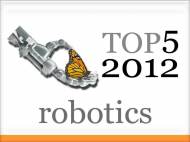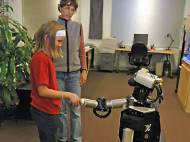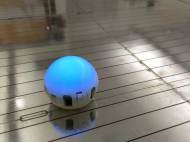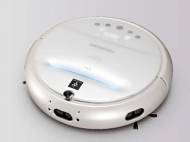Top 5 news and articles regarding robotics in 2012
 It seems as if last year’s news and articles were dominated by unmanned aerial vehicles and algorithms developed for their autonomy in different environments. We got a couple of new and affordable robotic toys to play with, there were numeral examples of robots whose design or locomotion principles were inspired by nature, and ASIMO turned 10 years a bit before Honda debuted Miimo robotic lawnmower. Aside various projects focused onto swarms of robots and related algorithms, there’s a notable growing number of robotic aids being developed for rehabilitation or for people with disabilities.
It seems as if last year’s news and articles were dominated by unmanned aerial vehicles and algorithms developed for their autonomy in different environments. We got a couple of new and affordable robotic toys to play with, there were numeral examples of robots whose design or locomotion principles were inspired by nature, and ASIMO turned 10 years a bit before Honda debuted Miimo robotic lawnmower. Aside various projects focused onto swarms of robots and related algorithms, there’s a notable growing number of robotic aids being developed for rehabilitation or for people with disabilities.
When it comes to top 5 news and articles about robotics that were published in 2012, here’s how the things stand:
5. Children’s social interactions with a humanoid robot
 This was a report about an interesting study where a group of researchers from the University of Washington used a Robovie robot to explore how children react to robots that could be used to monitor them and guard them from harm while parents are away. The robot was remotely controlled in a way that made it look as it was acting autonomously. While it is still a bit early for these robots to be used for such purposes, the results of the experiment were pretty interesting.
This was a report about an interesting study where a group of researchers from the University of Washington used a Robovie robot to explore how children react to robots that could be used to monitor them and guard them from harm while parents are away. The robot was remotely controlled in a way that made it look as it was acting autonomously. While it is still a bit early for these robots to be used for such purposes, the results of the experiment were pretty interesting.
As a part of the study, a researcher would interrupt the robot while it was its turn to say it was time for the interview part of the experiment and told Robovie that it had to go into a storage closet. When interviewed by the researchers, 88 percent of the children thought the robot was treated unfairly in not having a chance to take its turn, and 54 percent thought that it was not right to put it in the closet. Nearly 80 percent of the children believed that the robot was intelligent, and 60 percent believed it had feelings.
4. Project DEXMART sensitive robotic hand
 Researchers at Saarland University cooperated with their colleagues from Bologna and Naples to develop a robotic hand that employs small and high-speed electric motors to twist strings which mimic muscles in human body. Aside being able to exert high tensile forces within a compact space, the robotic hand is also delicate – making it useful to perform different tasks such as aid in your home or adding strength for rescuers in disaster scenarios.
Researchers at Saarland University cooperated with their colleagues from Bologna and Naples to develop a robotic hand that employs small and high-speed electric motors to twist strings which mimic muscles in human body. Aside being able to exert high tensile forces within a compact space, the robotic hand is also delicate – making it useful to perform different tasks such as aid in your home or adding strength for rescuers in disaster scenarios.
The development of the robotic hand is a part of the European project DEXMART – where an international group of scientists from eight universities and research institutes in Germany, France, Italy and Great Britain, worked over the past four years to develop various concepts that were mainly focused on improving the versatility of robotic arms.
3. Droplets – team of tiny swarming robots
 Surprisingly squeezed into 3rd place of most popular robotics news and articles published in 2012 is an article about Droplets which was published around 3 weeks ago. Droplet is a basic robotic building block developed by a group of researchers from the University of Colorado Boulder. Although it is fairly simple, the researchers hope they’ll be able to reproduce it in large quantities to develop swarming systems with gradually increasing complexity.
Surprisingly squeezed into 3rd place of most popular robotics news and articles published in 2012 is an article about Droplets which was published around 3 weeks ago. Droplet is a basic robotic building block developed by a group of researchers from the University of Colorado Boulder. Although it is fairly simple, the researchers hope they’ll be able to reproduce it in large quantities to develop swarming systems with gradually increasing complexity.
Each robot has the size of a pingpong ball and they move by using fixed legs and vibration motors. The robots can sense RGB color and IR, and transfer data among each other via analog or digital IR signals. In order to simplify and predict some of the tests, the researchers also developed a software simulation environment which consists of a simulator for the entire platform. This feature is useful for research because it allows the simulation on thousands of robots without the need to actually build them.
2. Talking vacuuming robots? Sharp Cocorobo RX-V80 and RX-V100
 Although I would like to congratulate to folks from Sharp for trying to develop something different, two versions of a robotic vacuum cleaner named Cocorobo (a play of words that combines “heart” and “robot” in Japanese) were a bit of an overkill when it comes to their features and price tag. More than twice as expensive as the popular iRobot’s Roomba, Cocorobo vacuuming robots come with Sharp Plasmacluster 7000 technology which is used to purify air during their operation.
Although I would like to congratulate to folks from Sharp for trying to develop something different, two versions of a robotic vacuum cleaner named Cocorobo (a play of words that combines “heart” and “robot” in Japanese) were a bit of an overkill when it comes to their features and price tag. More than twice as expensive as the popular iRobot’s Roomba, Cocorobo vacuuming robots come with Sharp Plasmacluster 7000 technology which is used to purify air during their operation.
Sharp wants to develop a new line of home appliances that have personality and communicate with their owners, like housekeeper pets. Both models feature Heart Engine Artificial Intelligence which enables the robot to respond to its instructions in a more natural manner. The robot answers in combination of lights and 36 phrases in 4 languages. It speaks in Japanese, hip humorous Kansai dialect, Chinese and English language.
1. Analyzing butterfly flight for better MAV maneuverability
 Johns Hopkins University (JHU) engineers used high-speed video cameras to figure out how butterflies manage to fly with amazing grace and agility and use that data in order to improve maneuvering capabilities of micro aerial vehicles (MAVs). Although MAVs could be very useful in search and rescue, exploration and environmental monitoring missions, their small size hinders their maneuverability.
Johns Hopkins University (JHU) engineers used high-speed video cameras to figure out how butterflies manage to fly with amazing grace and agility and use that data in order to improve maneuvering capabilities of micro aerial vehicles (MAVs). Although MAVs could be very useful in search and rescue, exploration and environmental monitoring missions, their small size hinders their maneuverability.
The researchers used three video cameras capable of recording 3,000 one-megapixel images per second to mathematically document the trajectory and body conformation of painted lady butterflies which flap their wings about 25 times per second. They observed how changes in mass distribution associated with the wing flapping and body deformation of a flying insect help it engage in rapid aerial twists and turns.








Leave your response!